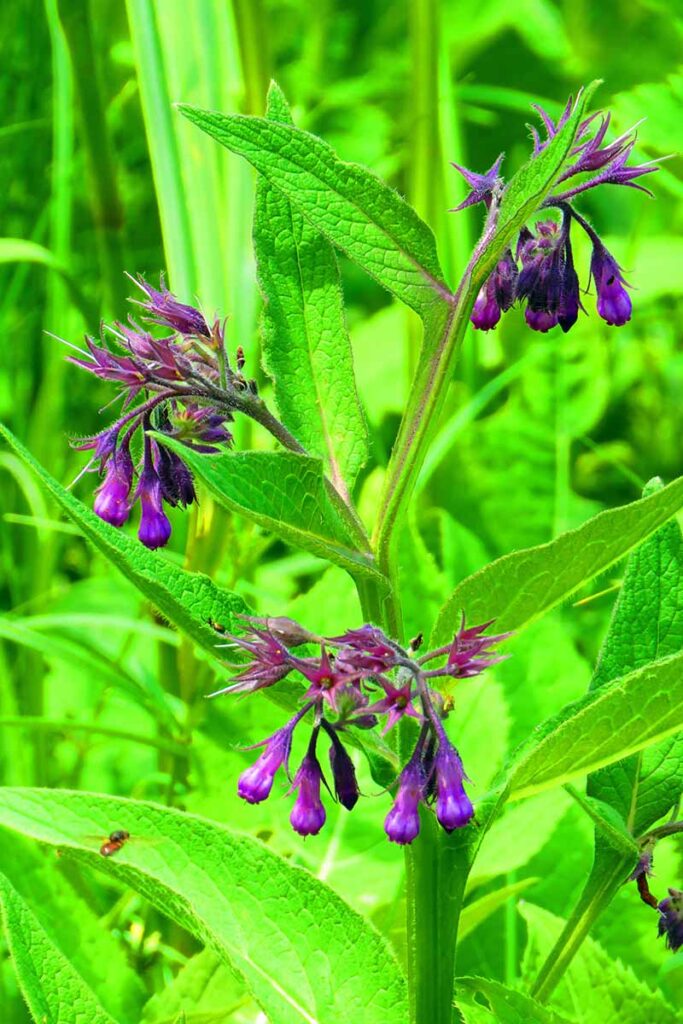
Comfrey is a wonderful herb! Simply amazing! It is so good, it is one of my top ten all time herbs! Comfrey is good for so many things! Let’s dive into comfrey and understand it more!
Comfrey grows in the shade or sun, although it likes growing in sunny locations better. It also loves a lot of water. It is usually found growing wild near bodies of water like streams or creeks.
In the past, comfrey has went by other names including knitbone, blackwort, bruisewort, and slippery root. Comfrey brings things together. It heals open wounds and bruises, helps with stomach ulcers, helps burns, helps bladder infections, heals broken bones, aids with gout, and assists with inflammation. This is just a few of the wonderful benefits!
The parts of comfrey that are medicinal are the leaves and roots. It is best to harvest the leaves when they are large. The roots are best harvested in the fall. You can use it internally or topically. Either the leaves or roots can be steeped to make a tea which will have soothing effects for gut inflammation, urinary tract infections, lung irritation, throat irritation, liver inflammation, gallbladder inflammation, canker sores, mouth sores, coughing, or when having post-dental procedures. A tea can even be made and used as an eye wash. You can even help an animal with mastitis or uterine infections by making comfrey tea and dipping their teats into it. If you are using it topically, comfrey is great for burns and wounds but do not use it if you have a puncture wound. It heals the outer skin so quickly that the internal parts of the puncture wound may not heal as fast which may lead to internal infection.
You can also ground it down (after drying it) and put it into capsules, use to make a poultice, or make a tincture. If you have hemorrhoids genital warts or postpartum tears, you can add comfrey to a tub of water as a sitz bath. Using comfrey topically has no side effects and is very safe. It can be used topically for gout and placed on the skin to heal broken bones.
It can also be used as a fertilizer. It is great in compost piles or around the base of trees. You can even make a comfrey tea and water your plants with the tea. Comfrey can also be used as fodder to feed livestock animals (In small quantities).
Comfrey (Symphytum Officinal) spreads by roots and seeds and can be invasive. It is very hard to control. But don’t fret, there is another type of comfrey called Russian comfrey and it has the same medicinal benefits. It will not spread easily and you can control it much easier. You can not take the seeds from Russian comfrey and replant them. It is just like when a horse and a donkey mate….they create a mule. That mule cannot procreate. The seeds of Russian comfrey are sterile.
When consuming comfrey internally for medicinal purposes, don’t take it if you have liver problems, pregnant, breastfeeding, or taking lots of prescription medications. It is also recommended that you do not take comfrey long term or in large amounts at one time.
One last thing to mention is how scientists will try to discourage people from consuming comfrey. There have been reports stating it is toxic to humans and animals; however, you have to look closely at the studies and how they were conducted. Case studies are different than controlled studies. Case studies have many unknown variables. Controlled studies takes into consideration every known variable possible. A case study was done with a group of six week old rats. In the case study, the six-week-old rats were fed a very concentrated form of comfrey as 40 percent of their diet and the rats developed liver tumors. Based off of this one case study (not a controlled study), scientist reported that comfrey was bad for humans to consume internally.
Number one… don’t eat comfrey as 40 percent of your diet. If you ate sugar as 40 percent of your diet, you would have repercussions. Also, don’t take it long term. Number two…Case studies have many, many variables. It isn’t a controlled setting. We do not know what else the rats ate or what their livers were before the study began. We don’t have all the information. Number three…All animals has different livers. Take dogs for example. Dog livers will not tolerate grapes whereas humans can eat grapes. Rats livers cannot tolerate chocolate whereas human livers can. It is not accurate to say that humans have the same liver reaction as rats. The rats could have been given 60 percent of their diet as chocolate in the case study. We just don’t know what the other 60 percent was because it was a case study and not a controlled study. Without having all the information and variables, there is no way to conclude that the rats developed liver tumors based on consuming comfrey. Comfrey has been consumed by human and used as an herbal medicine for more than two thousand years. If taken correctly, with the previously mentioned contraindications, comfrey can be very safe and very effective.
As you can see, comfrey is so amazing and beneficial! I highly encourage you to get this on your shelf now! Or at least growing in your backyard pharmacy!
If you want to purchase this herb, please consider using this affiliate link to purchase it. I highly recommend this link because of how they process and store herbs. You can’t always trust who you purchase from online, but with this company, I truly do feel it is top of the line and high quality. Just go to this link and type in ‘Comfrey’.
If you would like to find out more about the author or learn about other herbs, please consider visiting this link.
Stay natural!
~Dr. Amanda P. Cartwright